- Best bare bones option: Cacti
- Best for growing companies: Nagios XI
- Best for device flexibility: Zabbix
- Best add-ons: Progress WhatsUp Gold
- Best for complex environments: ManageEngine OpManager
- Best for app monitoring: Datadog
- Best for SMBs: Paessler PRTG Network Monitor
- Best for multi-platform companies: Wireshark
If you combine enterprise network monitoring tools with industry best practices for network management, you’ll gain fuller visibility over your assets and establish a healthier network environment. Depending on your company’s security requirements and levels of risk, you can get advanced network monitoring features or just the basics with our picks for the top tools.
Top network monitoring tools: Comparison table
We have a more detailed look at each product below, but if you’re looking to quickly compare these tools in a few key areas, here’s a comparison table of all the products we’ll cover:
| Software | Free trial available | Business size | Supported platforms | Deployment options |
|---|---|---|---|---|
| Cacti | No, but the software is free. | Small businesses. | Windows, Mac OS/X, Linux, Unix and any platform that meets the minimum requirements. | Cloud or on-premises. |
| Nagios | Yes. | Small to medium-sized businesses. | Windows, Mac OS/X and Linux/Unix. | Cloud or on-premises. |
| Zabbix | No, but the software is free. | Large businesses. | Linux, IBM AIX, FreeBSD, OpenBSD, NetBSD, Mac OS/X, Solaris, Windows and HP-UX. | Cloud or on-premises. |
| Progress WhatsUp Gold | Yes. | Any business size. | Windows Server. | Cloud or on-premises. |
| ManageEngine OpManager | Yes. | Large businesses. | Windows, Linux or Chrome/Firefox/Edge browsers. | Cloud or on-premises. |
| Datadog | Yes. | Medium-to-large-sized businesses. | Linux, Mac OS and Windows. | Cloud or on-premises. |
| Paessler PRTG Network Monitor | Yes. | Any business size. | Windows Server and Windows 10/11. | Cloud or on-premises. |
| Wireshark | No, but the software is free. | Any business size. | Windows Server, Windows 8/8.1/10/11 and Unix/Unix-like platforms. | Cloud or on-premises. |
Featured Partners
Best network monitoring software
To understand which network monitoring tool is best for your business, consider price, compatibility, support and design. The right software for your use case may surprise you.
Cacti: Best bare bones option

Cacti is a monitoring and fault management framework that integrates with the Simple Network Management Protocol and is useful for making graphical representations of network traffic. While it’s built for statistical modeling, the tool is a good option for those with the technical chops to integrate their SNMP data. Cacti offers six built-in themes for you to customize your experience and has been translated into many languages.
Pricing
- Cacti is a free tool released under the GNU General Public License.
Standout features
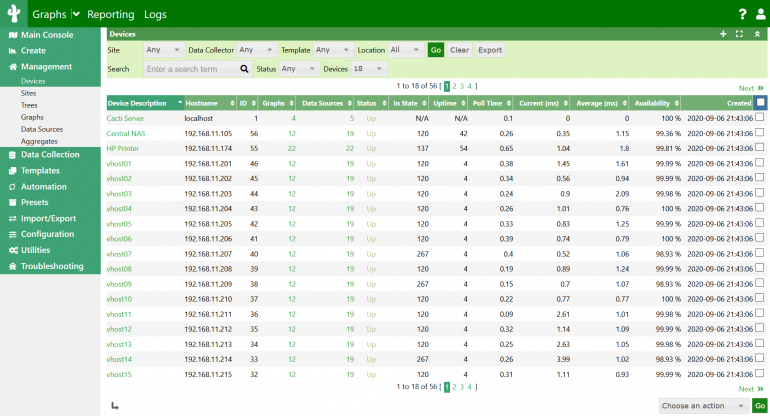
Cacti is an advanced template-based solution that allows you to work with the following features:
- Device templates.
- Graphs and graph templates.
- Data source management.
- Profiles.
- Data polling and collection.
- Packaging.
- Discovery and automation.
- Different graph-viewing options.
- Plugins.
- Group and domain management.
- An intuitive dashboard.
Pros
- It’s free.
- It’s RRDTool-based.
- The graphs are based on the SNMP protocol.
Cons
- Features are limited for many business use cases and requirements.
- The user interface is simple; some users may find it dated.
Use cases
Cacti is recommended for small businesses that may not need a complex network device monitoring service. Even though the platform offers plenty of features, others may give you a better experience via automations or quality-of-life updates.
Why we picked Cacti
Cacti is a free tool with the capabilities to provide the basic functions of network monitoring, provided that your team has staff that can understand statistical modeling and can connect and maintain the SNMP hook-up.
Nagios XI: Best for growing companies
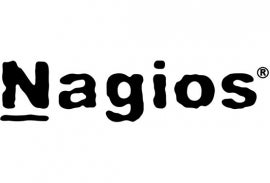
Nagios is a networking monitoring software solution that is available in both open-source and commercial, enterprise-level versions. Users have full access to the source code, which provides them with the opportunity to customize their experience within the tool. Enterprise users of Nagios XI can benefit from features like multi-tenant architecture and APIs for extendable architecture.
Pricing
In addition to the free and open-source Nagios Core, Nagios XI is available in the following plans:
- Standard Edition: Flexible pricing starting at $1,995.
- Enterprise Edition: Flexible pricing starting at $3,495.
Standout features
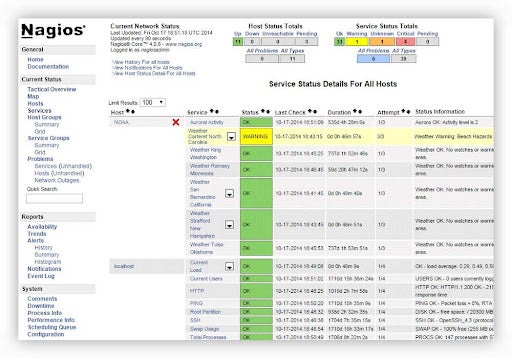
Nagio’s most useful features include the following:
- Comprehensive monitoring solutions.
- Quick problem remediation.
- Proactive planning.
- Reporting tools and third-party add-ons.
- Multi-tenant capabilities.
- Extendable architecture.
Pros
- Robust user community.
- Free version and free demo are both available.
- Compatible with a variety of operating systems and network devices.
Cons
- UI isn’t considered intuitive.
- Plugins aren’t always straightforward to install.
- Complicated configuration process.
Use cases
Nagios works for businesses that want more power than Cacti but don’t need some of the more powerful monitoring tools on the market. The platform attends to basic needs and not much more than that.
Why we picked Nagios XI
Nagios XI comes in two editions that build upon the Nagios Core edition. Growing companies that plan to expand their networks can easily scale from the free and open-source Core edition to the enterprise edition. This is especially helpful for organizations that need multi-tenant capabilities.
Zabbix: Best for device flexibility

Zabbix is a network monitoring and traffic analysis tool that is compatible with a variety of network protocols and devices operating within the same web console. Using this tool, you’ll be able to collect data and monitor your networks without having to open different tabs.
It’s important to note that Zabbix supports Hyper-V, VMware and other virtualization hypervisors. Even though you can run this platform without an agent by setting the SNMP protocol, it’ll be easier to manage everything with an agent.
Pricing
Zabbix is free and open-source software, but companies may need to contract with partners for implementation or support.
Standout features
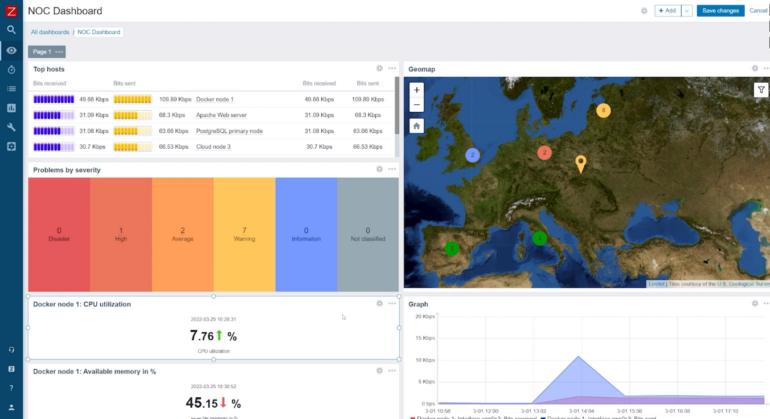
You’ll get plenty of templates applied by default. Some of these include templates for HTTP, ICMP, SMTP and IPMI protocols, as well as templates for Linux and Windows Server systems.
Other notable features of Zabbix include:
- Flexible metric collection.
- High-performance Zabbix agents.
- Agentless monitoring.
- Synthetic monitoring.
- Custom data collection methods.
- Data transformation.
- Machine learning and trend prediction.
- Auto-remediation.
Pros
- It has a lot of useful features for large businesses.
- It’s flexible.
- It can send you alerts when a device or link is down.
Cons
- It uses complex terminologies and must be set up manually.
- The user interface isn’t the best.
Use cases
Zabbix is a good fit for larger businesses, especially if they have more complex needs. Keep in mind, though, that Zabbix needs to be configured manually, component by component. Since the interface isn’t too intuitive, you may have to ask the support community for assistance.
Why we picked Zabbix
Zabbix is flexible and extensible for nearly any type of integration or device. This makes it ideal for companies with custom and wide-ranging monitoring needs.
Progress WhatsUp Gold: Best add-ons

Progress’s WhatsUp Gold is an IT infrastructure monitoring solution that gives users full visibility into everything connected to their network. You’ll be able to see your servers, virtual machines, network devices and cloud and wireless environments. This approach will help you make better diagnostic decisions when fixing network or component-specific problems.
This is an SNMP-based network monitoring solution that you can expand with different add-ons. A great benefit of this platform is that it’s easy to use. Thanks to its interactive map, you’ll easily get the information you need to evaluate the status of your devices.
Pricing
You’ll have to talk to a WhatsUp Gold representative if you want to get specific pricing information for the product. Each pricing option is a device-based licensing model that can be tailored to network requirements. Three product pricing tiers and plans are available to customers:
- Premium: Annual subscription license.
- Premium: Perpetual license.
- Total Plus: Perpetual license.
Standout features
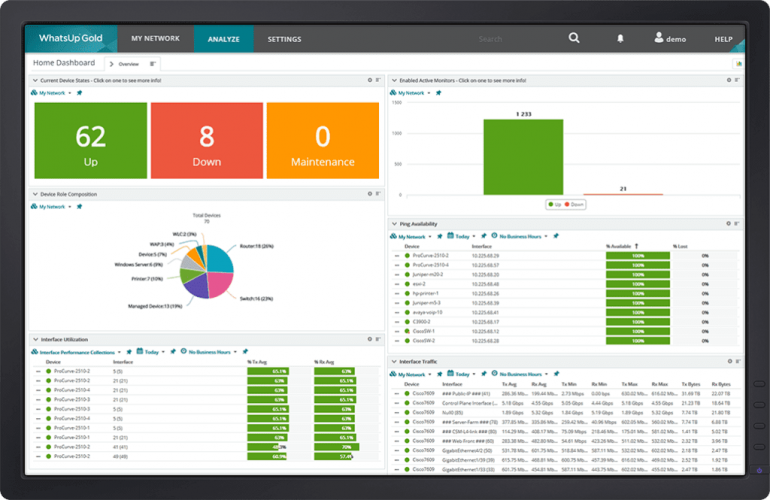
Popular features of this platform include:
- Log management.
- Alerts.
- Configuration management.
- Cloud-based resources.
- Application performance monitoring.
- Wireless network management.
- Flowmon NPMD/NDR.
- Network performance monitoring.
- Network mapping.
Pros
- It’s suitable for any business size or industry background.
- The interface is user-friendly.
- There are plenty of accessible and useful features.
Cons
- The number of features may be overwhelming for some users.
- It may be complex to manage your notifications.
- It can be costly, depending on the plan you select.
Use cases
We recommend this tool for any business that is willing to test or demo the solution first. It has plenty of basic and advanced features that cater to most needs, but you’ll still want to get a feel for its capabilities before committing.
Why we picked Progress WhatsUp Gold
WhatsUp Gold provides a modular pricing system that lets companies pick and choose the extra features they need. Combined with a modern UX and interactive network mapping, the software helps companies build the right monitoring system.
ManageEngine OpManager: Best for complex environments

ManageEngine OpManager is one of the most robust tools available for network monitoring today. Users often select this tool for its flexibility and ease of use. It gives them greater visibility into switches, firewalls, wireless LAN controllers, servers, storage devices, routers and more.
If you select the Standard version of this product, you’ll get basic monitoring, custom dashboards and notifications. Higher-tier plans give you extras like application-specific monitoring and advanced troubleshooting tools.
Pricing
Personalized pricing and packaging are available by user request. However, most users select one of the following three editions:
- Standard Edition: Starts at $245 for 25 devices.
- Professional Edition: Starts at $345 for 25 devices.
- Enterprise Edition: Starts at $11,545 for 250 devices.
Standout features
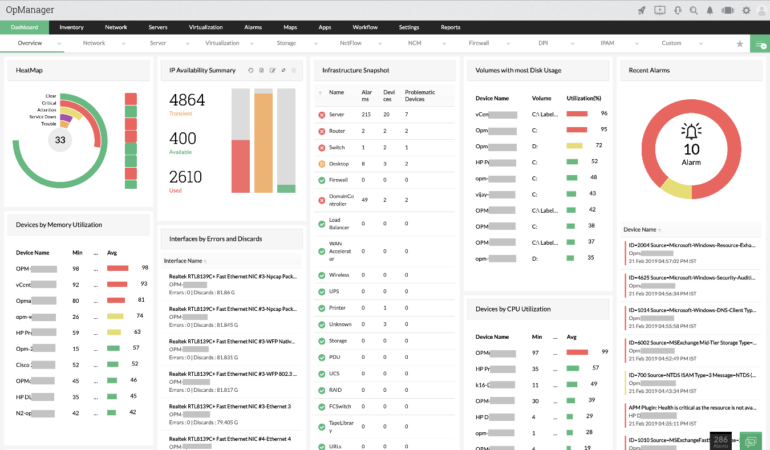
Here’s an overview of the features you’ll find in this network performance monitoring solution:
- Network and wireless network monitoring.
- WAN monitoring.
- Cisco ACI monitoring.
- Physical and virtual server monitoring.
- Storage monitoring.
- Distributed network monitoring.
- Network visualization.
- Fault management.
Pros
- It’s easy to set up.
- The reports are detailed and highly visual.
Cons
- It’s not suited for small businesses.
Use cases
ManageEngine is better for large businesses or medium-sized ones with complex networking environments and configurations.
Why we picked ManageEngine OpManager
ManageEngine OpManager is network monitoring software that can easily manage complex environments in an easy-to-use interface where admins can quickly find the root of problems in a single space.
Datadog: Best for app monitoring
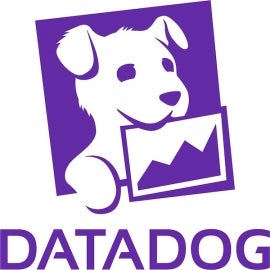
Datadog is an infrastructure and network monitoring tool that offers a wide range of products and features that cater to most business requirements. If you have complex infrastructure, applications, logs or other components to consider in your network, this is one of the most versatile options in this market.
Pricing
Pricing for Datadog depends on which category of network monitoring your organization is most interested in. Users can choose from plans that focus on infrastructure monitoring to log management, network monitoring and cloud security management. For users who are interested in the infrastructure plan group, which offers the most robust feature options, pricing breaks down into these three plans:
- Free: Starting at $0 for up to five hosts.
- Pro: Starting at $15 per host per month.
- Enterprise: Starting at $23 per host per month.
Standout features
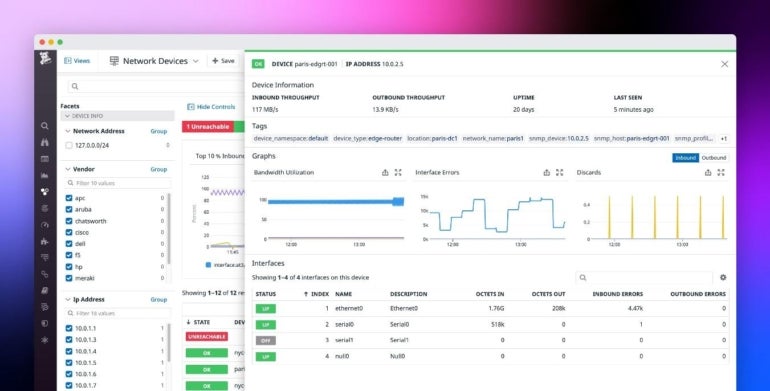
This platform offers many useful features, like the following:
- SaaS and cloud provider compatibility.
- Automation tools.
- Monitoring tools.
- Source control.
- Integrations.
- App performance troubleshooting.
- Log analyzing and filtering.
Pros
- It has plenty of features to track anything you want.
- Support for a variety of infrastructure and application types.
- Highly configurable.
Cons
- Some of the features are too complicated or technical for the average user to use well.
Use cases
Any business can use Datadog, although some of its features may not be a good fit for small businesses.
Why we picked Datadog
Datadog is a robust tool that can monitor a variety of networks, including infrastructure and app management. The variety of tools makes it ideal for SaaS and consumer-focused companies that need uptime monitoring and user analytics for their apps.
Paessler PRTG Network Monitor: Best for SMBs
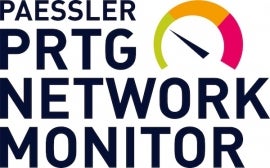
Paessler offers standard-but-capable features that allow you to monitor every element of your network infrastructure. The main benefit of using this platform is that it doesn’t overwhelm you with overly complex features. Because this tool can be used to monitor up to 1,000 devices and services, it is best suited for SMBs.
Pricing
PRTG Network Monitor is available in five different perpetual license options:
- PRTG 500: $1,899 per server license for monitoring up to 500 aspects, or around 50 devices.
- PRTG 1000: $3,599 per server license for monitoring up to 1,000 aspects, or around 100 devices.
- PRTG 2500: $7,399 per server license for monitoring up to 2,500 aspects, or around 250 devices.
- PRTG 5000: $12,999 per server license for monitoring up to 5,000 aspects, or around 500 devices.
- PRTG XL: $16,899 per server license for monitoring up to 10,000 aspects, or around 1,000 devices.
Standout features
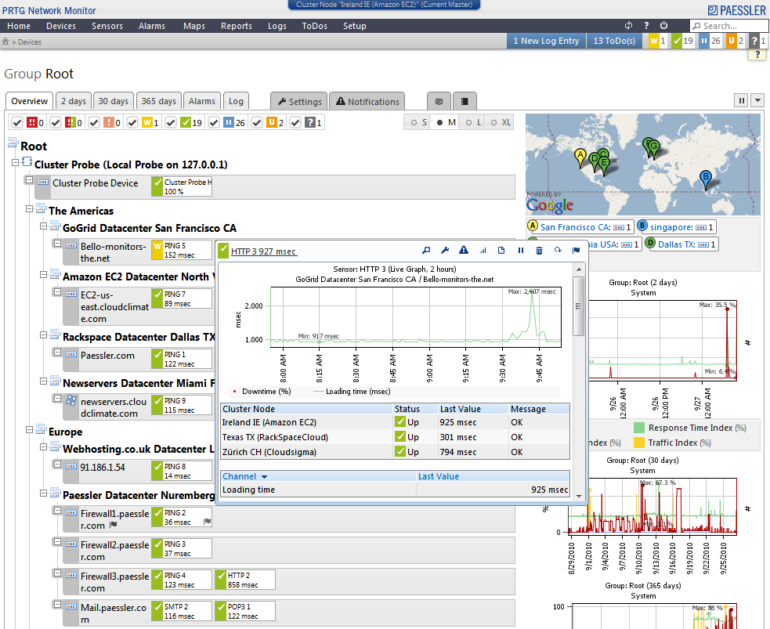
The best features you’ll get from Paessler include:
- Reporting modules.
- SNMP utilization.
- Graphs.
- Mobility.
- ITOps dashboards.
- Network monitoring.
- Notifications.
- Quick sensor discovery.
- Ping testing.
- Remote probe feature.
Pros
- It’s user-friendly.
- It’s scalable.
- It has all the features SMBs need for network monitoring.
Cons
- It’s not as affordable as other options.
- It only supports Windows.
- It may not have the capacity to manage larger and more complex enterprise environments.
Use cases
We recommend Paessler to people with small-to-medium-sized businesses and network environments.
Why we picked Paessler PRTG Network Monitor
Because Paessler PRTG Network Monitor is easy to use and scalable. It provides full reporting modules, a fully featured solution for Windows-only SMBs. The price is higher than some open-source options on this list, but you won’t be stuck with a tool that you can’t configure.
Wireshark: Best for multi-platform companies

Wireshark is a popular network traffic monitoring tool that works with most known protocols. As free and open-source software that supports nearly any operating system, it’s ideal for companies with a variety of business arms that need real-time analysis.
Pricing
Wireshark is a free, open-source network monitoring solution released under the GNU General Public License version 2.
Standout features
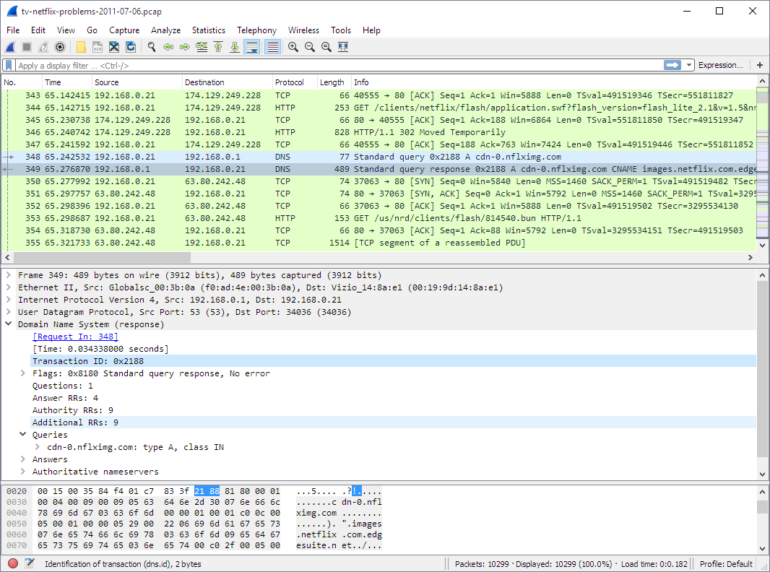
Wireshark is known for the following features:
- Deep protocol inspection capabilities.
- Live capture and offline analysis.
- Rich VoIP analysis.
- Decryption support for many platforms.
- Support for many capture file formats.
- Powerful display filters.
- Three-pane packet browser.
Pros
- It’s a free and open-source solution.
- It allows you to analyze packets on many different interfaces.
- It’s easy to identify and troubleshoot latency issues.
Cons
- The user interface is difficult to navigate for some users.
- You may get overwhelmed with the network information the platform throws at you at first.
Use cases
Wireshark seems to perform well for many business sizes and use cases. However, small businesses may have a few problems navigating the platform. It sometimes overwhelms smaller teams with the amount of information it provides.
Why we picked Wireshark
Wireshark is highly popular open-source software with a wide community for support, including education, a conference, and documentation. It is available for many protocols and operating systems, which is ideal for high-growth companies that will need to extend their monitoring.
What are the key features of network monitoring software?
There are dozens of different monitoring tools you can find online, but how can you make sure you’ve found the right one for your business? As a starting point, look for solutions that include these key features and capabilities:
- Real-time monitoring.
- Traffic analysis.
- Fault detection and alerting.
- Performance analysis and bandwidth usage.
- Customizable dashboards and reports.
- Remote monitoring capabilities.
Some products may have all of these features, whereas others may just have a few. It will be important for your team to determine which features are non-negotiable.
Factors to consider when choosing your next network monitoring tool
Not all tools are a one-size-fits-all solution. You must consider your needs and goals as a company if you truly want to choose the perfect network monitoring product and hopefully save money in the process.
Take your time when thinking about the particularities of your networking environment and the type of attention it requires. From there, you can select a product that’s a good fit for your business size, team expertise, security and compliance requirements and much more.
Here are some factors you should keep in mind when choosing network monitoring tools:
- Your organization’s scalability requirements and the current size of your network.
- Your team’s in-house technical expertise and ease-of-use requirements.
- Integration with other IT management tools.
- Cost and licensing options.
- Vendor reputation and support.
Open-source vs. commercial network monitoring solutions
Open-source software is free, which is probably its best feature. Users don’t have to closely partner with or meet vendors to access, configure and customize these tools to their liking. Open-source platforms also often receive support from their communities, meaning you’ll get regular updates and access to a forum where you can share your concerns with other people.
Unfortunately, since open-source platforms are less regulated, you may experience more problems or bugs while using this type of tool. Moreover, you will be responsible for fixing these problems most of the time.
Open-source updates are provided by volunteers, so there’s no set schedule for receiving them. This may be a setback for those who are looking for updated tools.
In contrast, commercial solutions offer users stability and maturity with standardized products. However, these products usually come with a higher price tag and may have greater limitations placed on user-level customizations.
Which one is right for your organization?
Does your team have people willing to deal with the volatility of open-source software? If it does, then you can save some money and select an open-source network monitoring solution.
On the other hand, if you have the budget and don’t want to worry too much about quality or stability, commercial network management tools will be a better fit. Regardless of which one you use, if you use your tool alongside IT network monitoring best practices, you’ll achieve consistent results that improve your network as a whole.
Protecting your network with network monitoring tools
Today’s digital world is filled with many potential risks. You must be prepared to monitor your network performance and activity at all times, whether it’s your wireless networks, firewalls or another component that lives on your network.
The network monitoring solutions covered in this guide do an excellent job of keeping everything safe. However, we recommend you take your time to consider your organization’s specific needs and goals. Each tool has different features that’ll help you, but a thorough evaluation will help you choose the right option.



